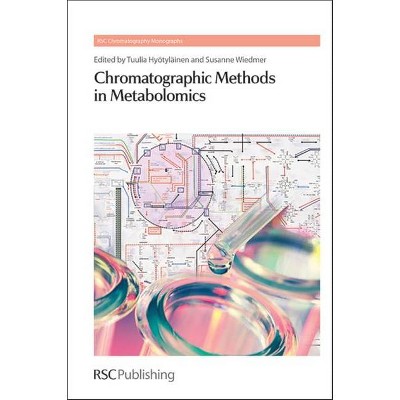Chromatographic Methods in Metabolomics - (RSC Chromatography Monographs) (Hardcover)

Similar Products
Products of same category from the store
AllProduct info
<p/><br></br><p><b> About the Book </b></p></br></br>This is an essential handbook for any laboratory looking to embark on a metabolomics research programme and includes the fundamentals of chromatography alongside the latest developments in the field.<p/><br></br><p><b> Book Synopsis </b></p></br></br>Metabolomics is an emerging field and this is the first book to present chromatographic techniques in metabolomics in a fundamental way. Sample preparation and quality control are crucial aspects which are described in detail. Uniquely, guidelines for the selection of appropriate methodology are also provided. The book covers the chromatographic techniques, such as liquid chromatography, gas chromatography, comprehensive two-dimensional gas chromatography and electrochromatographic techniques utilised in metabolomics.<p/><br></br><p><b> From the Back Cover </b></p></br></br>The concept of a metabolic profile was introduced in 1971, when gas chromatography demonstrated a range of compounds present in human samples. Now termed metabolomics, the field is still emerging, and chromatography remains an essential tool for determining metabolites in a living system. This is the first book to present the chromatographic techniques used in metabolomics in a fundamental way. Sample preparation and quality control are described in detail, and all forms of chromatography applied to metabolomics are included. The editors present guidelines on selecting the most appropriate methodology, making the book an accessible guide to anyone entering the field. Handling data and applications are also described. This is an essential handbook for any laboratory looking to embark on a metabolomics research programme and includes the fundamentals of chromatography alongside the latest developments in the field.<p/><br></br><p><b> Review Quotes </b></p></br></br><br><p>Tuulia Hyotylainen and Susanne Wiedmer have written and edited an excellent book on a very bold subject area that holds something for everyone. They have managed to get key workers to write chapters, which they have blended in with their own so that the book gives information suitable for a novice but also sufficient detail for an expert. I liked the way the editors have tackled the subjects full on and have written the very difficult chapters themselves and what could be more challenging in this respect than sample preparation. This they address in the first real chapter after the introduction. Of course it is not a full, all-encompassing description, you could write a whole book on this, but they have done an excellent job of condensing the topic to get the basic points across and extending these points in greater detail for the critical issues. An expert will read this and find holes in some of the methods described but they may also find new points that they have not considered. A novice will find the whole chapter very interesting; I did, but if I have a single complaint I would have liked to have seen more on the quality control of samples. An early chapter is on detection in metabolomics and of course the detector is the mass spectrometer. Hyotylainen and Wiedmer have avoided the easy trap of describing each type of mass spectrometer in detail; instead they describe the advantages and disadvantages of the various types and ionisation sources that become important for understanding the later chapters. In the chapter on techniques the authors have done a great job in bringing together the vast array of chromatographic techniques that are now available, assuming you have sufficient funds to buy them. Again another excellent chapter that describes the usefulness of the various techniques in metabolomics as opposed to describing the full technical details of each technique. I think a difficult chapter to have written is the one on gas chromatography in metabolomics. The scope for GCmetabolomics, as the authors point out, may not be as extensive as metabolomics in the liquid phase as it is limited to the analysis of small volatile metabolites but it can still provide excellent data for fingerprinting and profiling. The authors have tackled this well and although they do, as you might expect repeat areas already covered, they go into new details on GCxGC. The description of capillary electromigration and microchip technology work well together. The chapter on microchips contains many nice coloured photographs but it was rather like reading the menu at a Michelin Star restaurant without eating the food. The chapter describes many chips and platforms but, although much has been written about research using microchips in the last twenty years, the number of real commercial chips capable of providing real data is very small. This chapter does not provide the data we are all looking for but maybe like other papers on the subject it is a pointer to the future. If there is a chapter that is too short and does not provide sufficient information it is the one on data handing. As the authors point out, it is not possible to give a complete account of data handling that is required in this area, but I was left wanting to know more about the different techniques that are being used today, their limitations and how, using more and more powerful and new visual displays and virtual reality displays, we are moving forward. The last chapter is on applications. I was pleased that this was a small chapter. It is all too easy to do a literature search and print pages and pages of applications. The authors have not done this, they have carefully selected application areas, described key points and given sufficient references for the reader to find the extensive papers associated with each area. As you may have gathered, I liked this book and recommend it for both your own library, for your research lab and as a good book to recommend to anyone starting out in this very extensive but exciting field.</p>--Peter Myers, University of Liverpool "Chromatographia, 2014, 77:1405-1406 "<br><br>Book's topic Chromatographic Methods in Metabolomics is the 19th book in the series "RSC Chromatography Monographs". This monograph focuses on descriptions of important experimental aspects of metabolomics studies that use chromatography methods, including gas chromatography (GC) and liquid chromatography (LC), and other types of separation, including capillary electrophoresis (CE) and microchip technology. Detailed discussions are included of sample collection and preparation, data processing, and examples of applications of the techniques described. The editors state that the aim of the book was to give the reader an overview of chromatographic and electromigration techniques, and to provide practical guidelines for selecting the appropriate technique. Contents The book is 232 pages long and contains nine chapters. Chapter 1 introduces, in brief, the experimental workflow and analytical methods used in metabolomics studies. Chapter 2 describes the methods and techniques used in collecting and preparing a range of sample types, including mammalian biofluids, faecal samples, cells, and tissues. Techniques covered include quenching of materials, homogenisation, extraction, sample fractionation, and derivatisation for GC and LC. Chapter 3 discusses the mass spectrometry (MS) instruments used, including descriptions of the interfaces used to couple MSto GC, LC and CE, and comparisons of the mass analysers used. This chapter also discusses metabolite identification and fluxomics. Chapters 4-6 introduce the separation techniques used in metabolomics. Chapter 4 describes liquid chromatography techniques, including HPLC, UPLC, capillary LC, multi-dimensional LC, turbulent flow LC and supercritical fluid chromatography. Modes of liquid chromatography are also discussed. Chapter 5 introduces the techniques of GC-MS and GC×GC-MS, and includes discussions of sample collection for volatiles analysis and metabolite identification. Chapter 6 introduces capillary electromigration, with specific focus on CE, and includes descriptions of the interfaces used to couple CE to MS. Chapter 7 introduces innovative recent work on microchip fabrication and applications, including use of microchips for sample preparation, LC and CE. Chapter 8 discusses data handling, with emphasis on peak detection, alignment and deconvolution followed by normalisation and quantification. Chapter 9 describes specific applications of the techniques discussed in the previous chapters, with a focus on global profiling or targeted analysis of lipids or polar metabolites. Comparison with the existing literature This monograph adds to the growing number of recent textbooks and review articles focussing on the tools used in metabolomics and on the applications of metabolomics in biological sciences. Most other textbooks and review articles provide a detailed overview of either a broader (metabolomics in general) or narrower (e.g. GC-MS) range of metabolomics techniques and applications, with some including detailed procedures for the topics discussed. This monograph is unique in providing the first focused description of a specific range of chromatographic and separation techniques, thus enabling the reader to research each topic and choose appropriate techniques by consulting a single source. Critical assessment This is a general textbook on the metabolomics applications of chromatographic and separation methods, including GC, LC and CE as well as the emerging field of microfluidics and microchip fabrication. The contributing authors are global leaders in their field, with five of nine chapters written by Finnish authors. Each chapter provides a descriptive overview of a topic, and includes information on the important aspects researchers should consider. This approach achieves the editorial objective of enabling the reader to understand the principles and to make decisions regarding the appropriate techniques to use in their research. In several chapters, a greater diversity and number of references describing the research of global leaders in the field would have enabled the reader to research the experimental procedures in more depth. Some topics, namely quality control and metabolite information, are discussed in multiple chapters, and providing more focused and expansive chapters on these subjects would have been beneficial. Summary Chromatographic Methods in Metabolomics is a monograph providing overviews of separation techniques used in metabolomic studies, and of associated sample collection, sample preparation and data processing. Each chapter is written by an expert in the field, and all chapters are written with clarity and focus. The book is a single-source reference work, enabling the reader to understand the important aspects of each topic and providing the information necessary for the reader to investigate the chapter topics in more depth. The work would be an important addition to the bookshelf of under-graduate, post-graduate and post-doctoral scientists starting a research role applying metabolomics.--Warwick B. Dunn "Analytical and Bioanalytical Chemistry - # Springer-Verlag Berlin Heidelberg 2013 "<br><br><p>"Tuulia Hyotylainen and Susanne Wiedmer have written and edited an excellent book on a very bold subject area that holds something for everyone. They have managed to get key workers to write chapters, which they have blended in with their own so that the book gives information suitable for a novice but also sufficient detail for an expert...I liked this book and recommend it for both your own library, for your research lab and as a good book to recommend to anyone starting out in this very extensive but exciting field."</p>--Peter Myers, University of Liverpool "Chromatographia "<br><p/><br></br><p><b> About the Author </b></p></br></br><p>Tuulia Hyötyläinen is manager of metabolonomics at the VTT Technical Research Centre of Finland and has over a decade of experience in lecturing, researching, and developing chromatographic techniques. Susanne Wiedmer is based in the Department of Chemistry in the University of Helsinki. Her research is currently focussed on the properties and behaviour of liposomes, predominately using miniaturised analytical techniques.</p>
Price History
Price Archive shows prices from various stores, lets you see history and find the cheapest. There is no actual sale on the website. For all support, inquiry and suggestion messagescommunication@pricearchive.us


















